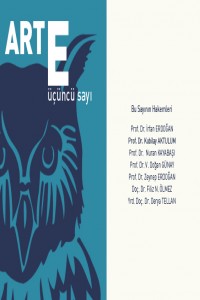Öz
The fact of “death” has been reflected in many weavings such as carpet, kilim, jejim, zili, soumak as both motifs and drawing compositions formed by gathering of motifs, and as possessions such as “weavings made and kept for burial” in Turkey. Carpets and kilims are produced to meet not only the physical needs of people but also their psychological expectations. When the emotions could not have been spoken and were to be expressed in a silent way, motifs were gathered in different colors and techniques and magnificent weavings came into existence. Each one of the motifs of the carpets and kilims has been weaved for thousands of years and has become the art of our ancestors. In this article, we have studied the fact of “death” which is reflected into Turkish weavings under the headlines of “motifs that directly symbolize death”, “motifs related to death” and “weavings made and kept for burial”. The research concluded that the motifs which directly symbolized death were bird, ram, sheep, horse, knife, cypress, chest, poppy, leaf, earring, deer, ewer, centipede, yel egdi (wind curved). In addition, information was gathered about the tradition of a special weaving, “made and kept for burial”, and examples were given for the specifications in regions such as Isparta, Kula, Afyon, and Denizli, where this tradition still continues.
Key Words: symbolism, weaving, carpet, kilim, Turkish art, motif, death
Öz
The fact of “death” has been reflected in many weavings such as carpet, kilim, jejim, zili, soumak as both motifs and drawing compositions formed by gathering of motifs, and as possessions such as “weavings made and kept for burial” in Turkey. Carpets and kilims are produced to meet not only the physical needs of people but also their psychological expectations. When the emotions could not have been spoken and were to be expressed in a silent way, motifs were gathered in different colors and techniques and magnificent weavings came into existence. Each one of the motifs of the carpets and kilims has been weaved for thousands of years and has become the art of our ancestors. In this article, we have studied the fact of “death” which is reflected into Turkish weavings under the headlines of “motifs that directly symbolize death”, “motifs related to death” and “weavings made and kept for burial”. The research concluded that the motifs which directly symbolized death were bird, ram, sheep, horse, knife, cypress, chest, poppy, leaf, earring, deer, ewer, centipede, yel egdi (wind curved). In addition, information was gathered about the tradition of a special weaving, “made and kept for burial”, and examples were given for the specifications in regions such as Isparta, Kula, Afyon, and Denizli, where this tradition still continues.
Ayrıntılar
| Birincil Dil | İngilizce |
|---|---|
| Bölüm | Makaleler |
| Yazarlar | |
| Yayımlanma Tarihi | 28 Nisan 2009 |
| Gönderilme Tarihi | 30 Nisan 2009 |
| Yayımlandığı Sayı | Yıl 2009 Cilt: 2 Sayı: 3 |


